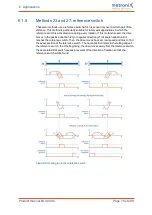
6 Applications
6.1.7
Methods -23 and -27: homing run (positive/negative)
to the reference switch
These methods are similar to the methods 23 and 27. However, in this case, the system
tries to locate the end of the range of movement, e.g. the stop or a limit switch, in a first
step. It is only then that the system searches for the reference switch. As a result, several
switches can be connected to the same input for the reference switch. During the homing
run, the "last" switch in the search direction will be used as the reference switch. In the
case of method -23, the drive moves in the positive direction first, and in the case of
method -27, it moves in the negative direction first. The home position refers to the edge of
the reference switch.
.
Figure 38: Reference switch with an initial movement in the positive and negative direction
6.1.8
Methods 32 and 33: homing to the index pulse
In the case of method 32 and method 33, the direction of the homing run is negative or
positive. The home position refers to the first index pulse of the angle encoder in the
search direction.
Figure 39: Index pulse with a negative (32) and positive (33) initial movement
Product manual BL 4000-C
Page 78 of 298
















































